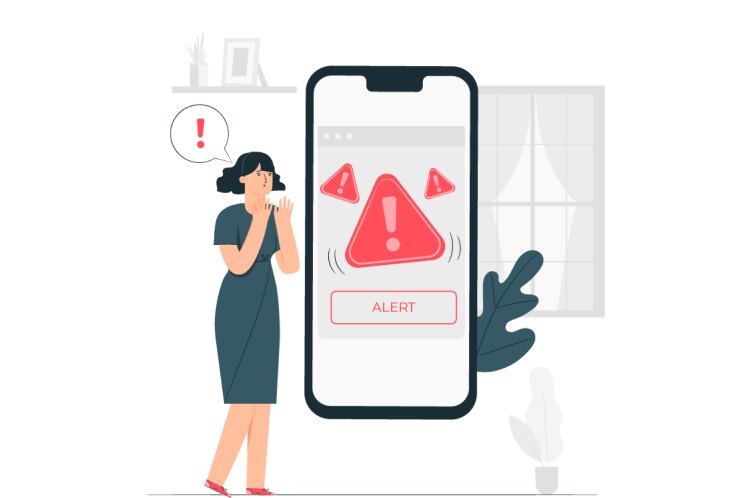
In the modern web of communication technology, there are so many fundamental components often overlooked yet hold immense value. One such essential yet overlooked element is the SMSC number – a number that works behind-the-scenes to ensure effective SMS communication. Often, mobile users are unaware of what is SMSC number, the role it plays in the delivery of SMS messages and how to find SMSC number on your device. This blog will be your useful guide for understanding the importance of SMSC numbers. So let’s get started.
What is SMSC?
A Short Message Service Center performs the processing of Short Message Service i.e. SMS messages. It is an essential element in the mobile network infrastructure. Acting as a central hub, an SMSC is the unit that receives, stores, forwards, and delivers SMS messages between mobile users or mobile devices.
What is SMSC Number?

Also known as SMS Gateway Number, SMSC is an alphanumeric identifier with a format similar to a standard phone number used to send SMS messages from the sender device or application to the SMSC. You can think of it as an address to which an SMS message is initially sent before being routed to the destination device.
Is SMSC Number Different From Phone Number?
Often SMSC numbers are confused with regular phone numbers. While both types of numbers play an important role in facilitating communication, they serve distinct functions. Let’s understand more to gain a clear understanding.
Characteristics of SMSC Numbers
- Numeric Format
Just like regular phone numbers, SMSC numbers are made up of strings of digits. However, their association with mobile subscribers or users is different than that of a regular phone number.
- Functionality
The primary purpose of an SMSC number is to manage the transmission of SMS messages.
- Location
SMSC numbers are maintained and managed by network operators of service providers. These numbers operate behind the scenes and are not meant to be directly used by end users.
Characteristics of Regular Phone Numbers
On the contrary regular phone numbers are meant to be used by individual subscribers. Besides SMS, these numbers are used to avail various services like voice calling.
- Assignment
Regular phone numbers are associated with specific devices and individual subscribers.
- Format
The format of regular phone numbers varies according to the country, region, and carrier.
- Functionality
Regular phone numbers support a variety of communication services such as voice calls, MMS, SMS, etc.
Do All Phones Have an SMSC Number?
All mobile phones that are capable of sending and receiving text messages are configured with an SMSC number. However, not all phones have an SMSC number directly embedded in them. Here’s the breakdown:
Feature Phones
Those older, non-smartphone models come with an SMSC number embedded by the network carrier or manufacturer.
Old Android Models
Certain Android devices, particularly the old models come with SMSC numbers embedded in them, depending upon the carrier and the manufacturer.
Phones without SMSC Embedded Directly
Newer Smartphone models including Android and iOS devices usually do not come with SMSC numbers embedded directly in them. Rather, the phone fetches the SMSC information directly through the network configuration.
How does SMSC Work?
I’m going to explain the workings of an SMSC using an example outlining every step of the process.
1. Message Submission by the Sender
Suppose you compose a message on your mobile phone. Now, you send this message to the recipient contact by hitting the send button. From this step onwards, the role of SMSCs comes into the picture.
2. Message Reception at the SMSC
The message sent by you first reaches the SMSC associated with your mobile network operator. Upon receiving the message, the SMSC checks the message for validity i.e. it ensures that the text or content of the message meets technical requirements and security standards.
3. Recipient Lookup by SMSC
At this stage, the SMSC needs to verify the recipient network and location. For this, it queries databases such as HLR and VLR to obtain the current location of the recipient’s device.
To understand this step in more depth, let’s have a look at what is HLR and VLR:
HLR is The Home Location Register which is a central database that maintains information about the current location of the mobile devices registered to that network. The information it stores about the subscribers includes MSISDN, subscriber profile, current service profile, and the location where the subscriber was last registered. When an SMSC queries HLR to retrieve the current location of the recipient’s device, it provides the SMSC with the necessary information.
VLR is The Visitor Location Register is a temporary database that is associated with each MSC i.e. Mobile Switching Center. This database has essential information such as mobile subscriber identity, location area, subscriber services, preference, etc., about the mobile devices that are currently within the coverage area served by MSC. The role of VLR in SMS delivery comes into action when a mobile user roams into a new MSC coverage area. It is when the VLR associated with that MSC temporarily stores the subscriber’s information obtained from the HLR. It provides MSC with necessary information about the subscriber and thus assists in routing messages.
4. Routing Decision Made by SMSC
Now, according to the information obtained in the previous step, the SMSC decides a suitable delivery route for the message. If the subscriber’s current network is the same, then the message is directly routed to the current MSC or VLR. However, if the recipient is on a different network, then interconnection agreements with other operators are used.
5. Delivery Attempt Made by SMSC
At this step, the SMSC attempts to deliver the message to the mobile device of the recipient as per the determined route.
If in case the recipient is unavailable, the SMSC stores the message. It then performs delivery attempts periodically until successful (within the defined period for message storage which is typically 24 hours, after that message is discarded.)
6. Delivery Confirmation by SMSC
Once the recipient receives the message, it sends back a notification to the SMSC which then informs the sender i.e. you about the delivery status.
All the above steps present a simplified overview of how SMS messages are delivered by SMSCs.
Features of SMSC
Besides all that we have learned about the functions performed by SMSCs, there are 2 distinctive features of SMSCs that we must know about:
Unique Timestamps on Text Messages
When a message is sent, it is stamped with an ‘Exact Time’ of being received by the SMSC. Now, as the SMSC stores and forwards the SMS message, the time stamp remains unchanged. This feature of SMSCs helps in ensuring the integrity and context of SMS communication especially when dealing with time-sensitive messages.
Support for Various SMS Formats
Another feature that adds to the efficiency of SMSCs is that they are designed to handle a variety of SMS formats. Some typical examples include concatenated messages, flash messages, etc.
Quality of Service Management
SMSCs perform various functions to ensure the quality of SMS communication. From monitoring the network performance to message delivery times as well as checking error rates, SMSCs ensure optimum service levels.
Importance of SMSC Numbers in Modern Mobile Communication
SMSCs perform various tasks to ensure messages reach their intended destinations. Here are some key functions performed by SMSCs that make up their role in mobile communication.
Routing SMS Messages
When an SMS message leaves its origin, it carries the information about the destination within itself. It is the SMSC that reads this information and guides the SMS message to the correct recipients, even when the device at the receiving end is not available. An SMSC determines the best possible path considering the network and mobile phone location.
Storing SMS Messages
In a case when SMSC attempts the delivery of an SMS message but finds that the recipient’s phone is unavailable, it stores the SMS message for a defined period. During this duration, it keeps track of the recipient device and once the device becomes available, SMSC attempts the delivery again. This functioning of SMSC ensures that messages aren’t lost.
Message Delivery Reports
The SMSC also provides the delivery reports to the sender. This is done to inform the sender whether the SMS message was successfully delivered.
Spam and Security Filtering
Besides routing and delivery of SMS messages, some Short Message Service Centers also perform filtering of SMS messages. This helps in reducing unwanted spam and malicious messages thus ensuring security in mobile communications.
SMSC Number Use Cases
Let’s examine some real-world scenarios and use cases where SMSC numbers are used:
1. International Messaging

When a message is sent to someone in another country, then the message passes through the SMSC associated with that region. Suppose User A is in the United States and sends a message to User B who is in France. The message is likely to be routed through the French SMSC to reach its destination.
2. Business Communication

SMS is a popular tool leveraged by businesses around the world for customer engagement, marketing campaigns, and other notifications. Every time a message or a campaign is released by the business, it is the SMSCs that take those messages to their target audience effectively, promptly, and reliably.
3. Emergency Alerts

During emergencies such as natural disasters, government agencies often utilize SMSC numbers to circulate critical information to the public. Such SMS messages are routed through specialized SMSCs dedicated to emergency communications, thus ensuring timely delivery of messages.
How to Find Your SMSC Number?
Finding the SMSC number can vary depending on your mobile phone device and its operating system. However, I would list out the general steps to locate and view SMSC numbers on Android and iOS devices.
How to Check SMSC Number on Android?
Steps Check SMSC Number Using the Phone App
- Open the Phone app on your Android device.
- Tap the menu icon (usually three dots or lines) to access additional options.
- Look for an option labeled “Settings” or “Call settings.”
- Within the settings menu, you may find an option specifically for “SMSC” or “Message Center.” Tap on it to view the SMSC number configured on your device.
Steps to Check SMSC Number Using the Messaging App
- Open the Messaging app on your Android device.
- Tap the menu icon (usually three dots or lines) to access additional options.
- Look for an option labeled “Settings” or “Messaging settings.”
- Within the settings menu, you may find an option to view or edit the SMSC number.
Steps to Check SMSC Number Using the System Settings
- Navigate to the Settings app on your Android device.
- Look for the “Network & Internet” or “Connections” section.
- Depending on your device, you may find an option for “Mobile networks” or “SIM card & mobile network.”
- Within these settings, you may find an option to view or edit the SMSC number.
How to Find SMSC Number on iOS Devices (iPhone)?
Steps to Check SMSC Number Using the Phone Settings
- Open the Settings app on your iPhone.
- Scroll down and tap on “Messages.”
- Look for an option labeled “Message Center” or “SMSC.” Tap on it to view the SMSC number configured on your device.
Steps to Check SMSC Number Using a Dial Code
- Open the Phone app on your iPhone.
- Dial the following code: *#5005*7672#
- Press the Call button. This should display the SMSC number configured on your device.
How to Check SMSC Number on Other Devices?
For devices running other operating systems or feature phones, the method to find the SMSC number may vary. You may need to consult the user manual or contact your mobile network operator for assistance.
SMSC Numbers and Mobile Network Operators
The SMSC number is a critical part of the mobile network infrastructure, often referred to as “the backbone of SMS communication”. Every MNO manages its own SMSC infrastructure which includes SMSC numbers dedicated to their network. SMSC numbers are pivotal for the smooth functioning of MNOs, as they route, store, and deliver text messages within their network and to other networks. MNOs configure SMSC parameters including routing rules, storage settings, and delivery policies to maintain their service quality. The performance of SMSC numbers directly impacts the service quality of MNOs.
Key Takeaway – What is SMSC Number?
In summary, all mobile devices rely on SMSC numbers to send and receive SMS messages. However, not all devices need to come with an embedded SMSC number, many latest mobile devices fetch SMSC directly from network configurations. One must keep in mind that modifying the SMSC number incorrectly can affect your SMS communication. When it is necessary to change your SMSC number, you may check your mobile phone’s settings, use an appropriate third-party app, or simply ask for assistance from the customer support of your network carrier.
Frequently Asked Questions
What is the primary role of an SMSC number?
It identifies the SMS center that routes and delivers SMS messages, ensuring successful transmission across mobile networks. Without it, messages may fail to reach recipients.
Why might I need to change my SMSC number?
Reasons include switching carriers, traveling internationally (to use local networks), or troubleshooting SMS delivery issues like delays or failures
How do I check and update my SMSC number?
- Android: Use *#*#4636#*#* to access SMSC settings.
- iPhone: Dial *#5005*7672# for viewing/updating.
- Contact your carrier if needed
What problems occur with an incorrect SMSC?
Issues include failed message delivery, delays, or increased costs due to misrouting, especially during carrier or SIM changes
How does SMSC improve security?
By integrating with firewalls, SMSCs block spam, phishing, and spoofing attempts, ensuring secure and reliable SMS traffic




























